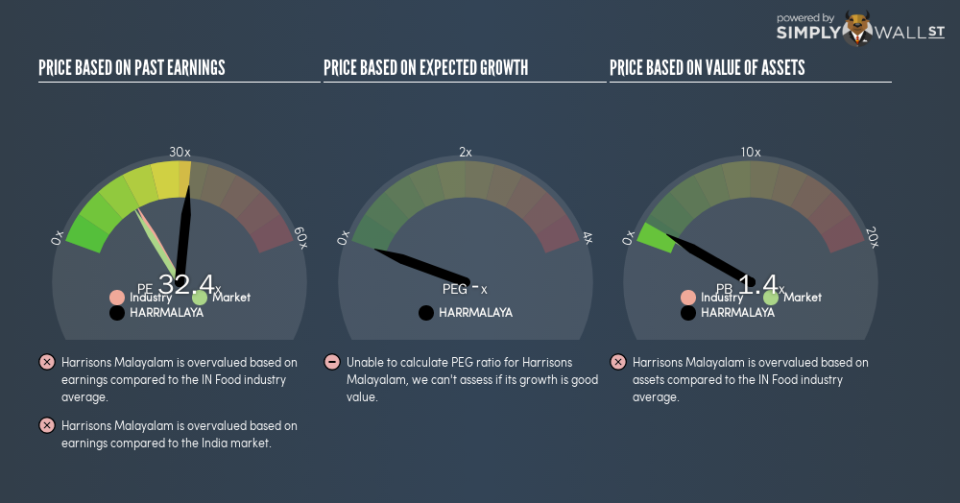Don’t Sell Harrisons Malayalam Limited (NSE:HARRMALAYA) Before You Read This

The goal of this article is to teach you how to use price to earnings ratios (P/E ratios). We’ll show how you can use Harrisons Malayalam Limited’s (NSE:HARRMALAYA) P/E ratio to inform your assessment of the investment opportunity. Harrisons Malayalam has a price to earnings ratio of 32.39, based on the last twelve months. That corresponds to an earnings yield of approximately 3.1%.
See our latest analysis for Harrisons Malayalam
How Do I Calculate A Price To Earnings Ratio?
The formula for P/E is:
Price to Earnings Ratio = Share Price ÷ Earnings per Share (EPS)
Or for Harrisons Malayalam:
P/E of 32.39 = ₹78.05 ÷ ₹2.41 (Based on the year to March 2018.)
Is A High P/E Ratio Good?
A higher P/E ratio implies that investors pay a higher price for the earning power of the business. That is not a good or a bad thing per se, but a high P/E does imply buyers are optimistic about the future.
How Growth Rates Impact P/E Ratios
Probably the most important factor in determining what P/E a company trades on is the earnings growth. Earnings growth means that in the future the ‘E’ will be higher. Therefore, even if you pay a high multiple of earnings now, that multiple will become lower in the future. So while a stock may look expensive based on past earnings, it could be cheap based on future earnings.
Harrisons Malayalam’s earnings per share were pretty steady over the last year. But EPS is up 75% over the last 3 years.
How Does Harrisons Malayalam’s P/E Ratio Compare To Its Peers?
We can get an indication of market expectations by looking at the P/E ratio. As you can see below, Harrisons Malayalam has a higher P/E than the average company (17.4) in the food industry.
Its relatively high P/E ratio indicates that Harrisons Malayalam shareholders think it will perform better than other companies in its industry classification. Shareholders are clearly optimistic, but the future is always uncertain. So investors should delve deeper. I like to check if company insiders have been buying or selling.
Remember: P/E Ratios Don’t Consider The Balance Sheet
It’s important to note that the P/E ratio considers the market capitalization, not the enterprise value. That means it doesn’t take debt or cash into account. Theoretically, a business can improve its earnings (and produce a lower P/E in the future), by taking on debt (or spending its remaining cash).
Such spending might be good or bad, overall, but the key point here is that you need to look at debt to understand the P/E ratio in context.
Harrisons Malayalam’s Balance Sheet
Net debt totals 63% of Harrisons Malayalam’s market cap. This is enough debt that you’d have to make some adjustments before using the P/E ratio to compare it to a company with net cash.
The Bottom Line On Harrisons Malayalam’s P/E Ratio
Harrisons Malayalam’s P/E is 32.4 which is above average (16.4) in the IN market. With meaningful debt and only modest recent earnings growth, the market is either expecting reliable long-term growth, or a near-term improvement.
Investors should be looking to buy stocks that the market is wrong about. If the reality for a company is better than it expects, you can make money by buying and holding for the long term. Although we don’t have analyst forecasts, shareholders might want to examine this detailed historical graph of earnings, revenue and cash flow.
But note: Harrisons Malayalam may not be the best stock to buy. So take a peek at this free list of interesting companies with strong recent earnings growth (and a P/E ratio below 20).
To help readers see past the short term volatility of the financial market, we aim to bring you a long-term focused research analysis purely driven by fundamental data. Note that our analysis does not factor in the latest price-sensitive company announcements.
The author is an independent contributor and at the time of publication had no position in the stocks mentioned. For errors that warrant correction please contact the editor at editorial-team@simplywallst.com.

